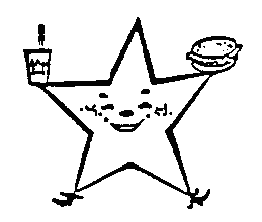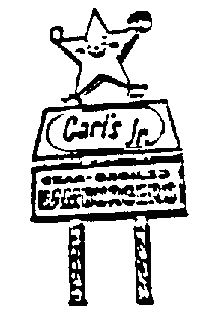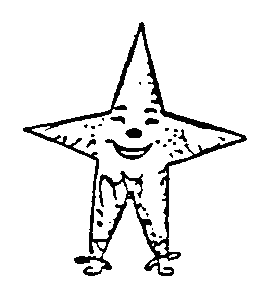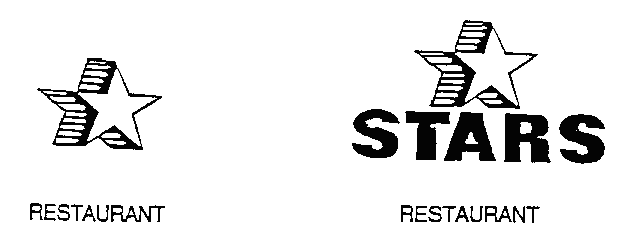Trademark Trial and Appeal Board
Patent and Trademark Office (P.T.O.)
*1 CARL KARCHER ENTERPRISES, INC.
v.
STARS RESTAURANTS CORP.
January 24, 1995
Hearing: December 15, 1993
Opposition Nos. 77,850 and 78,828 to application Serial Nos. 73/643,525 and 73/643,526 filed on February 9, 1987
Before Rice, Seeherman & Quinn
Administrative Trademark Judges
Opinion by Quinn
Administrative Trademark Judge
Stars Restaurants Corp. has filed applications to register the marks shown below [FN1] for "restaurant services."

Carl Karcher Enterprises, Inc. has opposed registration in each instance on the ground of likelihood of confusion under Section 2(d). [FN2] In support of its opposition, opposer asserts prior use of the word STAR and various design representations of a star in connection with restaurant services. Opposer also pleads ownership of the following subsisting registrations:
for "restaurant services"; [FN3]
for "restaurant services"; [FN4]

for "restaurant services"; [FN5]
for "restaurant services"; [FN6] STAR CHEESEBURGER for "preparing and serving cheeseburgers as part of restaurant services"; [FN7] HAPPY STAR for "restaurant services featuring a children's hamburger"; [FN8] STAR HAMBURGER for "preparing and serving hamburgers as part of restaurant services"; [FN9] CARL'S FAMOUS STAR for "restaurant services featuring the sale of a special type of hamburger"; [FN10] SUPER STAR for "preparing and serving hamburgers as part of restaurant services"; [FN11] OLD TIME STAR for "restaurant services"; [FN12]
for "restaurant services"; [FN13]
for "restaurant services"; [FN14]
for "French fried onion rings, French fried potatoes, hash browned potatoes, specially prepared baked potatoes, cooked sausage, cooked bacon, soups, chili con carne with beans, specially cooked eggs and omelettes, milk, fruit jellies and jams, salad dressings, for consumption on or off the premises"; [FN15] and
for "paper napkins, paper bags, food wrappers, and paper place mats; drinking straws; and disposable coffee cups, paper cups, and disposable food containers." [FN16] Opposer claims that applicant's marks, when applied to restaurant services, so resemble opposer's previously used and registered marks referenced above as to be likely to cause confusion, or to cause mistake, or to deceive.
Applicant, in its answers, denied the salient allegations of the oppositions.
The record consists of the pleadings; the files of the opposed applications; trial testimony, with related exhibits (including opposer's pleaded registrations) taken by each party; applicant's responses (including appendices) to certain discovery requests introduced into evidence by opposer's notice of reliance; and applicant's responses to certain discovery requests made of record under Trademark Rule 2.120(j)(5) by way of applicant's notice of reliance. Both parties filed briefs on the case and both were represented by counsel at an oral hearing held before the Board.
Evidentiary Objections
*2 Opposer moved to strike portions of applicant's notice of reliance. Opposer essentially contends that seven of applicant's discovery responses which were relied upon by applicant do not pertain to the issue of likelihood of confusion and, under Trademark Rule 2.120(j)(5), do not clarify the discovery responses relied upon by opposer so as to make them not misleading.
Applicant filed a late brief objecting to opposer's motion. Opposer then moved to strike this late brief, requesting that its motion relating to applicant's notice of reliance be deemed conceded. Applicant, in response, gave no reason for the five-day delay in filing its brief, but merely argued that opposer's motion to strike portions of the notice of reliance should not be deemed conceded.
Given the unexplained delay in applicant's filing of a responsive brief, we will not consider this brief. However, even if the brief were considered, it is not persuasive inasmuch as we find opposer's motion to be well taken on its merits. Simply put, the objected-to responses do not serve, as contemplated by Trademark Rule 2.120(j)(5), "to make not misleading" what was offered by opposer. Accordingly, opposer's motion to strike certain portions of applicant's notice of reliance is granted. Trademark Rule 2.120(j)(5). Applicant's responses to opposer's interrogatory nos. 1, 5(a), 8(a), 8(e), 20 and 36 (first set) and applicant's response to opposer's interrogatory no. 20 (second set) are stricken from applicant's notice of reliance. We hasten to add, however, that even if the responses were considered, the result on the merits in these oppositions would be the same. In any event, the stricken information is mainly cumulative of facts brought out in the testimony of applicant's witnesses.
Opposer also moved to strike Exhibit A, consisting of a trademark search report, attached to applicant's final brief on the case. The motion is accompanied by counsel's declaration. Applicant filed a brief in response wherein it "agrees that Exhibit A, Applicant's Trial Brief, is inadmissible evidence." Applicant goes on to state that it "has not introduced nor claimed to introduce Exhibit A as admissible evidence but rather attached Exhibit A to Applicant's Trial Brief merely for demonstrative purposes."
In view of the above, opposer's motion to strike is granted and Exhibit A attached to applicant's brief has not been considered in reaching our decision.
Finally, we turn our attention to opposer's "post hearing submission of case law." Following up on a point of discussion at the oral hearing, opposer filed a copy of a published Board decision which, according to opposer, supports its position taken at the oral hearing. Applicant filed an objection, essentially arguing that the Board did not request this material nor do the Trademark rules of practice permit such a filing.
Opposer's filing is superfluous. The Board obviously is aware of its published case law and would consider, in any event, relevant published decisions.
*3 One other preliminary matter requires comment. Earlier in this litigation applicant sought to amend its recitation of services by limiting the identified services, and to amend the drawing by claiming the color green as a feature of the mark. The Board, in an order dated October 1, 1992, denied the proposed amendments. Thus, as will be apparent from the discussion below, we have based our decision on a consideration of applicant's marks without color as a feature thereof, and on applicant's recitation reading "restaurant services."
The Parties
Opposer is engaged in the fast food restaurant business. Opposer's founder began with a hot dog stand, and, through later years, opposer expanded into a chain of 630 restaurants. Opposer owns 378 of them, and 252 of the restaurants are owned by franchisees. The CARL'S JR. restaurants operate in the states of California, Nevada, Arizona and Oregon. Patrons may eat in the restaurants' dining areas or carry out the food. In addition, the majority of opposer's restaurants offer drive-through service. Opposer's recent annual sales figures range from $335.7 million in 1986 to approximately $614 million in 1992. Annual advertising expenditures range from about $18 million in 1983 to $39.2 million in 1990. Opposer advertises its restaurants on television and radio, in print media, and on billboards and posters.
Applicant also is engaged in the fast food restaurant business, operating 38 restaurants in Texas and Oklahoma. The restaurants feature a drive-in format with car hops delivering food/beverage orders to parked cars; the restaurants do not have seating or drive-through window service. The restaurants mainly are located in small towns and are advertised in local newspapers and on local radio stations.
In view of opposer's ownership of valid and subsisting registrations, there is no issue with respect to opposer's priority. See: King Candy Co., Inc. v. Eunice King's Kitchen, Inc., 496 F.2d 1400, 182 USPQ 108 (CCPA 1974). In any event, the record establishes opposer's earlier use.
Likelihood of Confusion
Our determination of likelihood of confusion under Section 2(d) must be based on an analysis of all of the probative facts in evidence that are relevant to the factors bearing on the likelihood of confusion issue. See: In re E.I. du Pont de Nemours & Co., 476 F.2d 1357, 177 USPQ 563 (CCPA 1973). The factors deemed pertinent in these consolidated proceedings now before us are discussed below.
Similarity/Dissimilarity of Services
For purposes of our analysis, there can be no dispute on this point. Both opposer and applicant are rendering restaurant services under their respective marks and the recitation of services in applicant's applications, and in many of opposer's registrations, is simply "restaurant services." Thus, at least insofar as these proceedings are concerned, the services are legally identical. Applicant makes an ill-founded attempt to distinguish its services from those of opposer, arguing that applicant's drive-in restaurant services are different from opposer's sit-down and/or drive-through restaurant services. In that connection, as noted above, applicant even filed a proposed amendment to specifically limit its services. However, as pointed out by opposer, opposer's registrations bear no limitations and, because the recitation "restaurant services" is broadly worded, it is presumed that the registrations cover all types of restaurant services, including those of the type offered by applicant. Further, applicant argues that opposer markets its services to upper and middle income consumers whereas applicant directs its marketing to lower-income consumers. Again, neither party's recitations of services bear any such limitation, and we must assume, not unreasonably here, that the same classes of consumers are patrons of both restaurant chains.
Conditions of Sale
*4 It is clear that the purchase of fast foods often is made on impulse. Further, as shown by the record, the fast foods offered at the respective parties' restaurants are relatively inexpensive. These facts weigh in favor of a finding of likelihood of confusion. See: Burger Chef Systems, Inc. v. Burger Man, Inc., 492 F.2d 1398, 181 USPQ 168, 169 (CCPA 1974), rev'g 176 USPQ 191 (TTAB 1972) [finding of a likelihood of confusion based, in part, on "the circumstances of use of the marks by the parties in chain restaurants catering to the motorist trade where many customers are on the move and in a hurry and often select their eateries on the basis of casual recollection of what they may have experienced in other places at other times ..."]. See also: Frisch's Restaurants, Inc. v. Elby's Big Boy of Steubenville, Inc., 670 F.2d 642, 214 USPQ 15, 20 (6th Cir.1982) [fast food products "are not likely to be the object of intensive consumer research, but rather subject to 'impulse buying"'].
Similarity of the Marks
Opposer took the testimony of Donald Karcher, opposer's president and chief operating officer; Rory Murphy, a senior vice president in charge of operations for opposer; and Richard Celio, opposer's vice president and general counsel. Their testimony, together with the related exhibits, shows that opposer has continuously used for over forty years "star" word marks and star design marks in one form or another in connection with its restaurants. The marks have evolved over the years into many different forms, both written and design. In point of fact, a "table tent" (opposer's ex. 7) used by opposer to commemorate its fiftieth anniversary in 1991 highlights, albeit in abbreviated fashion, this "evolution" of opposer's ever-changing star design.
In written form, the "STAR" word marks appear in the hamburger/cheeseburger sections of opposer's menus and on the paper wrapping for opposer's so-named products. In a design form, opposer's star has taken on a variety of forms and has not been, in the Board's words in a prior decision, "a unitary static symbol." Carl Karcher Enterprises, Inc. v. MTS Franchise Corp., 213 USPQ 254, 256 (TTAB 1980). A star design in one form or another has appeared in virtually every advertisement and promotion run by opposer, and various representations of "non-humanized" stars have been displayed throughout opposer's operations. An example of the ubiquitous use of stars by opposer is an informational brochure distributed by opposer (opposer's ex. 11) regarding its history; the brochure is titled "The story behind the star." Different sections of the brochure are captioned as follows: "How the star was born."; "Where people are the stars."; "What's written in the stars."; and "Map to the stars' homes.", which map identifies opposer's restaurant locations with a star.
*5 Messrs. Karcher and Celio testified further regarding opposer's use of unanimated (or non-humanized) stars. Such star designs are part of the decor of a majority of opposer's restaurants, the stars appearing on glass partitions that separate booths. Employees in the restaurants wear uniforms and hats on which unanimated star designs appear. Opposer also uses unanimated star designs for directional signs around the restaurants. The star-shaped signs bear the particular address of the restaurant, as well as such words as "please yield", "enter" and "drive through." Mr. Murphy characterized a star symbol as being opposer's "unifying corporate identity", a statement which, given the record before us, appears quite correct.
At the outset, we recognize that there are obvious differences between the involved marks. Nonetheless, we find that these marks are sufficiently similar in overall commercial impression that, when used in connection with identical services, confusion is likely to occur. See: Century 21 Real Estate Corp. v. Century Life of America, 970 F.2d 874, 23 U.S.P.Q.2d 1698, 1700 (Fed. Cir. 1992) [when marks appear on identical goods or services, the degree of similarity between the parties' marks necessary to support a conclusion of likely confusion declines]. The test to be applied in determining likelihood of confusion is not whether the marks are distinguishable upon side-by-side comparison, but rather whether the marks, as they are used in connection with the parties' services, so resemble one another as to be likely to cause confusion. This test requires us to consider the fallibility of human memory, and that the average purchaser normally retains a general rather than a specific impression of trademarks. See: Spoons Restaurants Inc. v. Morrison Inc., 23 U.S.P.Q.2d 1735 (TTAB 1991), affirmed in unpublished opinion, Appeal No. 92-1086 (Fed.Cir. June 5, 1992).
In light of the similarities in sound, appearance and meaning between, on the one hand, opposer's STAR word marks and star design marks and, on the other hand, applicant's marks, we think that the marks convey similar commercial impressions when used in connection with identical services. The fact that opposer's use of STAR word marks and star design marks has not been static and has taken on different forms and variations is a significant factor in this case. See: Carl Karcher Enterprises, Inc. v. MTS Franchise Corp., supra at 254.
Fame
Opposer contends that its " 'star' marks are famous marks," and that the "fame is established by the length of use of the marks, extent of sales under the marks, and the extent of advertising using the marks." (brief, p. 20). Opposer further asserts that applicant's evidence of third-party use of other star marks does not diminish this fame. Applicant counters by pointing to its evidence of third-party use of other star marks and concludes that opposer's marks are weak and entitled to only a narrow scope of protection.
*6 Opposer certainly has enjoyed considerable success with its restaurants. Opposer's sales in the period 1986-1992 exceed $3.3 billion, with 1992 sales of over $614 million. Opposer traditionally spends 4% of its gross sales revenues on advertising. Opposer's figures for the period 1983-1990 show that opposer spent almost $247.5 million on advertising, with expenditures in 1990 of $39.2 million.
Opposer consistently has used a star mark, in one form or another, for over forty-five years. During that time, as shown by opposer's sales, opposer has enjoyed considerable success. Moreover, opposer has expended considerable sums in promoting its restaurant services under its marks, with advertising in all types of media.
The evidence of record, when taken as a whole, indicates that opposer's star marks are well known in its specific area of operation, namely California, Arizona, Oregon and Nevada. In other words, the evidence does not establish that opposer's marks are nationally famous. Rather, opposer has established local notoriety in its trading area. See: Giant Food, Inc. v. Nation's Foodservice, Inc., 710 F.2d 1565, 218 USPQ 390, 394 (Fed.Cir.1983); and Berghoff Restaurant Co. v. Washington Forge, Inc., 225 USPQ 603 (TTAB 1985). Finally, for the reasons set forth in our discussion regarding third-party use, infra, such third-party use has not diminished the notoriety of opposer's marks in its trading area.
To rebut the evidence offered by opposer showing that opposer's marks are locally well known, applicant has offered evidence relating to third-party uses and registrations of star marks. More specifically, applicant introduced a trademark search report showing eight federally registered "star" word marks (with one of the marks being opposer's and another two owned by the same third-party) for restaurant services and some food items. [FN17] In addition, applicant introduced testimony relating to various "star" word and star design designations being used by restaurants. Applicant also has relied upon prior litigations between opposer and two third-parties.
Turning first to the third-party registrations, we see an initial problem. Although not raised as an objection by opposer, it is settled that third-party registrations may not be made of record by introducing a trademark search report wherein the registrations are mentioned. See: Riceland Foods Inc. v. Pacific Eastern Trading Corp., 26 U.S.P.Q.2d 1883, 1885 (TTAB 1993).
In any event, with respect to the third-party registrations, such evidence, as often stated, is of little probative value in determining likelihood of confusion issues. The report obviously is not evidence that the marks shown therein are either registered or in use, or that purchasers are familiar with them. Moreover, none of the registrations is for the same mark as any of opposer's marks.
*7 Applicant also has introduced testimony and evidence regarding actual use of "star" word marks and star design marks by third parties in the restaurant field. Roy Garza, one of applicant's supervisors, traveled throughout the United States to document these uses. [FN18] Mr. Garza identified some forty-two restaurants, thirty of which are located in California. Applicant highlights, in its brief, ten of these uses which presumably constitute the ones deemed most probative by applicant.
The Board has in the past given weight to evidence of widespread and significant use by third parties of marks containing elements in common with the mark being opposed on grounds of likelihood of confusion to demonstrate that confusion is not, in reality, likely to occur in the marketplace. See: Miles Laboratories Inc. v. Naturally Vitamin Supplements Inc., 1 U.S.P.Q.2d 1445, 1462 (TTAB 1987). The justification is, of course, that the presence in marks of common elements extensively used by others unrelated as to source may cause purchasers not to rely upon such elements as source indicators, but to look to other elements as a means of distinguishing the source of the goods/services. By relying on the third-party star marks in the restaurant field, applicant would have us conclude that small variations in the star marks used in the field, including opposer's and applicant's marks, are sufficient to avoid confusion.
We have carefully considered the evidence of third-party use, but find that it is not persuasive to reach the result urged by applicant. We are not the least bit surprised that the word "star" and/or various star designs appear in connection with restaurants, as they undoubtedly do in connection with many other goods and/or services. That is to say, we recognize that a star design is a common shape, and that such designs, as well as the word "star", are laudatory in nature. Nonetheless, applicant's evidence of third-party use is balanced by opposer's evidence of its marks' considerable notoriety. We have no problem concluding that opposer's marks are strong, even in the face of applicant's evidence. We believe that opposer's survey, discussed infra, demonstrates this point. Notwithstanding the third-party uses documented by applicant in California, in this survey undertaken by opposer, more than fifty percent of the respondents surveyed in California regarded applicant's marks as indicating opposer as the source of the restaurant services rendered under those marks.
We see some other problems which limit the probative value of the evidence of third-party use. Many of the marks being used are less similar to opposer's marks than are applicant's marks. Further, applicant has not furnished any evidence regarding the extent of use of the marks by these third parties. The geographic locations of these restaurants, in many instances, are relatively obscure. Moreover, the pictures of these restaurants tend to indicate that the operations are small and local in nature.
*8 In sum, the evidence of third-party use is of limited probative value to support applicant's position.
Survey
Opposer has introduced the results of a shopping mall intercept survey (opposer's ex. 59), with the supporting testimony of George Mantis, a survey expert, who designed the survey and analyzed the results. The survey was conducted in July 1991 at four malls in California, two being located in Sacramento, and one mall each in Los Angeles and Orange County. The purpose of the survey "was to determine who consumers believe owns or operates a restaurant that uses [the applied-for marks]."
The survey was taken of 403 individuals between the ages of 16 and 64 who visit fast-food restaurants at least once a month. Qualified respondents were then handed a card which showed one of the two marks reproduced below. [FN19]
In each instance, after viewing the mark, the respondent was asked the following question: "Who do you believe owns or operates a restaurant that uses the symbol [or "the symbol and word"] shown on this card?" If the respondent mentioned an entity in response to this question, a follow-up question was posed: "What makes you think this restaurant is owned or operated by _____?" (the blank being filled in with the name of the entity identified by the respondent in the preceding answer).
Of the two hundred and two respondents shown the star design only, 69.8TATED A BELIEF THAT OPPOSER OWNS OR OPERATES A RESTAURANT THAT USES THE STAR DESIGN. OF THE TWO HUNDRED AND ONE RESPONDENTS SHOWN THE STARS WORD AND DESIGN MARK, 53.7% STATED A BELIEF THAT OPPOSER OWNS OR OPERATES A RESTAURANT THAT USES THE STARS WORD AND STAR DESIGN MARK. WHEN ASKED THE FOLLOW-UP QUESTION RELATING TO EACH MARK, 56.9% AND 49.3% OF THE RESPONDENTS, RESPECTIVELY, MENTIONED "STAR-RELATED" REASONS FOR THEIR BELIEF THAT THE RESTAURANT IS OWNEDDD OR OPERATED BY OPPOSER. OPPOSER CONTENDS THAT THE SURVEY RESULTS SHOW THAT THERE IS A STRONG LIKELIHOOD OF CONFUSION IF APPLICANT'S MARKS WERE TO BE USED IN OPPOSER'S TRADING AREA.
Applicant has countered with the testimony of Carl Block, Ph.D., president of a marketing research company. Dr. Block has critiqued opposer's survey, leveling several criticisms at the survey's universe, survey administration and management, and stimulus.
At the outset, we note one commentator's observation that "[i]t is notoriously easy for one survey expert to appear to tear apart the methodology of a survey taken by another." J.T. McCarthy, McCarthy on Trademarks and Unfair Competition § 32.50[5] (3d ed. 1994). Courts and the Board long have recognized that there is no such thing as a perfect survey and, like any survey, the one presently before us involves a bit of a guessing game by the survey's respondents.
Be that as it may, the survey results support opposer's position on the issue of likelihood of confusion. The results indicate that confusion would be likely to occur if applicant were to open restaurants under its marks in opposer's trading area. We find Dr. Block's criticisms of the survey to be largely without merit and, to the extent that Dr. Block identified any true flaw, the shortcomings do not seriously undermine the results. We do not find the survey questions to be biased but, rather, to be in keeping with fairly standard survey formats, and Dr. Block's criticisms relating to the methodology fall short. Having said this, we think it is important specifically to address one of the objections raised by Dr. Block.
*9 Dr. Block contends that opposer's survey is flawed in that no one was questioned in applicant's trading area of Texas and Oklahoma. Contrary to Dr. Block's contention, we agree with opposer that opposer was not required to also take the survey in applicant's trading area in order to validate the survey results. The federal court cases cited by applicant [FN20] in support of its argument that the survey should have included the market areas of both parties are inapposite to this case. The issue here involves applicant's right to a nationwide registration, while the court cases involved an alleged infringing use. That is to say, opposer, in this proceeding, is not attempting to enjoin applicant from using its marks in Texas and Oklahoma, but, rather, opposer is objecting to applicant's attempt to obtain nationwide registrations of its marks which would presumptively cover opposer's present market area. It bears repeating here that applicant is seeking geographically unrestricted registrations which would be entitled to various presumptions under Section 7(b), including the presumption of a registrant's exclusive right to use the registered marks in commerce for restaurant services. In this connection, we would point to language from our primary reviewing court in a case, not unlike the present one, involving geographically remote uses:
Applicant seeks a geographically unrestricted registration under which it might expand throughout the United States. Under these facts, it is not proper, as the TTAB found, to limit our consideration to the likelihood of confusion in the areas presently occupied by the parties. Section 7(b) of the Trademark Act of 1946, 15 U.S.C. § 1057(b), creates a presumption that the registrant has the exclusive right to use its mark throughout the United States. Therefore, the geographical distance between the present locations of the respective businesses of the two parties has little relevance in this case. See, Amcor, Inc. v. Amcor Industries, Inc., 210 USPQ 70, 77 (TTAB 1981).
Giant Food, Inc. v. Nation's Foodservice, Inc., 710 F.2d 1565, 218 USPQ 390, 393 (Fed.Cir.1983). An opposer need not show a likelihood of confusion in areas outside of its own market area. Thus, there is no basis for the position that the survey should have been taken in applicant's trading area as well as opposer's. We therefore have no problem with the survey's having been taken in opposer's trading area only.
Actual Confusion
Applicant would have us conclude that the absence of actual confusion is a strong indicator that there is no likelihood of confusion between the parties' marks. Applicant points to the seven years of contemporaneous use of the marks without any instances of actual confusion.
The lack of evidence of actual confusion, despite contemporaneous use of the parties' marks for a period of more than seven years, is not significant given the circumstances of the parties' respective uses. Applicant's argument that this factor supports its position rings hollow in light of applicant's own assertion that the parties "operate in distinct and independent market areas." (brief, p. 20). Simply put, the absence of actual confusion is easily explained by the fact that the parties operate in different geographic areas. As noted above, opposer's restaurants are located in California, Nevada, Arizona and Oregon, whereas applicant's restaurants are located in Texas and Oklahoma. Although opposer did, in fact, operate five restaurants in Texas for a period of time, the last restaurant was closed in January 1987; that is only three months after applicant opened its first restaurant under its STARS marks. It also should be pointed out that in the short period of overlapping use, applicant did not open a restaurant in any of the cities where opposer's restaurants were located. In short, there has been little geographic overlap in the activities of the parties, and what little overlap existed was of a very short duration.
*10 Under the circumstances, we are not persuaded that there has, as yet, been any real opportunity for actual confusion to arise. Moreover, evidence of actual confusion is hard to come by and, in any event, the test under Section 2(d) of the Act is not actual confusion but likelihood of confusion.
Another factor to be considered is that applicant was aware of opposer's STAR marks when applicant commenced use of its marks. A trademark search report commissioned by applicant regarding the word mark STARS listed opposer's registered STAR word marks. Further, applicant received a written opinion of counsel wherein counsel pointed to the numerous listings of STAR marks which, in counsel's words, "would seem to indicate that the mark is generally available to anyone." However, counsel went on to highlight opposer's STAR HAMBURGER mark, pointing out that "[c]onceivably, you could face some resistance from [opposer]." (applicant's ex. 30).
Although there is no evidence of bad faith intent on applicant's part (and, indeed, opposer does not contend that there was any), the fact remains that a newcomer has both the opportunity and the obligation to avoid confusion. Consequently, a party which knowingly adopts a mark similar to one used by another for the same or closely related goods or services does so at its own peril; all doubt on the issue of likelihood of confusion must be resolved against the newcomer. See, e.g.: Kimberly-Clark Corp. v. H. Douglas Enterprises, Ltd., 774 F.2d 1144, 227 USPQ 541 (Fed.Cir.1985).
We conclude that consumers familiar with opposer's restaurant services rendered under its various STAR word and/or design marks would be likely to believe, upon encountering applicant's STARS marks for restaurant services, that the services originated with or were somehow associated with or sponsored by the same entity.
Decision: The consolidated oppositions are sustained and registration to applicant is refused in each instance.
J.E. Rice
E.J. Seeherman
T.J. Quinn
Administrative Trademark Judges, Trademark Trial and Appeal Board
FN1. Application Serial Nos. 73/643,525 and 73/643,526, respectively, both alleging dates of first use of October 15, 1986. Both applications include the following statement: "The lining shown in the mark is a feature of the mark and does not indicate color."
FN2. Pursuant to the parties' stipulation, proceedings in the two oppositions were consolidated.
FN3. Registration No. 914,469, issued June 8, 1971; renewed. The representation of a cup and hamburger are disclaimed apart from the mark.
FN4. Registration No. 919,121, issued August 24, 1971; renewed. The words "Char-Broiled Hamburgers" and the representation of a cup and hamburger are disclaimed apart from the mark.
FN5. Registration No. 965,266, issued July 31, 1973; renewed.
FN6. Registration No. 972,063, issued October 30, 1973; renewed.
FN7. Registration No. 1,003,855, issued February 4, 1975; combined Sections 8 and 15 affidavit filed. The word "Cheeseburger" is disclaimed apart from the mark.
FN8. Registration No. 1,084,351, issued January 31, 1978; combined Sections 8 and 15 affidavit filed.
FN9. Registration No. 1,085,162, issued February 7, 1978; Section 8 affidavit accepted, Section 15 affidavit filed.
FN10. Registration No. 1,097,025, issued July 18, 1978; combined Sections 8 and 15 affidavit filed.
FN11. Registration No. 1,099,039, issued August 8, 1978; combined Sections 8 and 15 affidavit filed.
FN12. Registration No. 1,111,995, issued January 23, 1979; combined Sections 8 and 15 affidavit filed.
FN13. Registration No. 1,112,013, issued January 23, 1979; combined Sections 8 and 15 affidavit filed.
FN14. Registration No. 1,151,330, issued April 14, 1981; combined Sections 8 and 15 affidavit filed.
FN15. Registration No. 1,297,845, issued September 25, 1984; combined Sections 8 and 15 affidavit filed.
FN16. Registration No. 1,383,339, issued February 18, 1986; combined Sections 8 and 15 affidavit filed.
FN17. This search report (applicant's ex. 29) also lists various state registrations and common law uses. With respect to these specific items, the search report, standing alone, has no probative value for our purposes.
FN18. Some of the marks, as pointed out by opposer, are used in connection with services (e.g. a grocery store and a bank) which are different from restaurant services. These uses are of little relevance to the likelihood of confusion issue in the present case.
FN19. As is apparent, Mr Mantis, in administering the survey, added the word "restaurant" to the specific marks sought to be registered by applicant. Mr. Mantis testified that the term was added
[t]o place the stimulus in context so the respondent could address the questions in context of how the registrations are used. It basically focuses the respondent on a segment of the marketplace for which the registrations are sought. (Mantis dep., p. 31).
When asked about this point on cross-examination, Mr. Mantis indicated that the results "may be different" if the word "restaurant" were not added to the marks. He went on to reiterate, however, that he believed it necessary to give a context to the marks sought to be registered.
Suffice it to say that we do not view the addition of "restaurant" to the applied-for marks as undermining the survey results; rather, the word "presents the mark in the context of a particular segment of market, enabling respondents to focus upon that segment." See: Miles Laboratories Inc. v. Naturally Vitamin Supplements Inc., supra at 1460.
FN20. Amstar Corp. v. Domino's Pizza, Inc., 615 F.2d 252, 205 USPQ 969 (5th Cir.1980), reh. denied, 617 F.2d 295 (5th Cir.1980), and cert. denied, 449 U.S. 899, 208 USPQ 464 (1980); Spraying Systems Co. v. Delavan Inc., 726 F.Supp. 772, 19 USPQ 1121 (N.D.Ill.1191), aff'd, 975 F.2d 387, 24 U.S.P.Q.2d 1181 (7th Cir.1992); and King-Size, Inc. v. Frank's King Size Clothes, Inc., 547 F.Supp. 1138, 216 USPQ 426 (S.D.Tex.1982).









